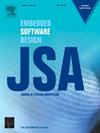基于生成变分和并行算法的经典-量子NISQ混合架构数据聚类
IF 4.1
2区 计算机科学
Q1 COMPUTER SCIENCE, HARDWARE & ARCHITECTURE
引用次数: 0
摘要
聚类是一种成熟的无监督机器学习方法,用于自动分类数据。在大型数据集中,这种算法的经典版本只有在大量计算资源可用(例如GPU)时才能表现良好。与经典方法相比,一种独特的计算框架依赖于集成量子处理单元(QPU)来降低计算成本。这是通过QPU利用量子效应(如叠加和纠缠)的能力来实现的,以本地并行计算或近似概率计算的多维分布(玻恩规则)。在本文中,我们首先提出了一种适用于混合CPU-QPU架构的聚类算法,同时考虑到当前噪声中等规模量子(NISQ)技术的局限性。其次,我们提出了一种量子算法,利用量子物理的概率性质来充分利用我们的QPU的潜力。我们的方法利用了生成机器学习算法和变分量子算法(VQA)的思想,设计了一种基于所谓量子电路出生机器(QCBM)混合的混合QPU-CPU算法。我们在IBM量子机上实现并测试了算法的质量,然后将其并行化,以更好地利用量子资源并加快基于量子的聚类算法的执行速度。最后,总结在NISQ上利用CPU-QPU架构进行数据集群的经验教训。本文章由计算机程序翻译,如有差异,请以英文原文为准。
Data clustering on hybrid classical-quantum NISQ architecture with generative-based variational and parallel algorithms
Clustering is a well-established unsupervised machine-learning approach to classify data automatically. In large datasets, the classical version of such algorithms performs well only if significant computing resources are available (e.g., GPU). A distinct computational framework compared to classical methods relies on integrating a quantum processing unit (QPU) to alleviate the computing cost. This is achieved through the QPU’s ability to exploit quantum effects, such as superposition and entanglement, to natively parallelize computation or approximate multidimensional distributions for probabilistic computing (Born rule).
In this paper, we propose first a clustering algorithm adapted to a hybrid CPU–QPU architecture while considering the current limitations of noisy intermediate-scale quantum (NISQ) technology. Secondly, we propose a quantum algorithm that exploits the probabilistic nature of quantum physics to make the most of our QPU’s potential. Our approach leverage on ideas from generative machine-learning algorithm and variational quantum algorithms (VQA) to design an hybrid QPU–CPU algorithm based on a mixture of so-called quantum circuits Born machines (QCBM). We implemented and tested the quality of our algorithm on an IBM quantum machine, then parallelized it to make better use of quantum resources and speed up the execution of quantum-based clustering algorithms.
Finally, summarize the lessons learned from exploiting a CPU–QPU architecture on NISQ for data clustering.
求助全文
通过发布文献求助,成功后即可免费获取论文全文。
去求助
来源期刊

Journal of Systems Architecture
工程技术-计算机:硬件
CiteScore
8.70
自引率
15.60%
发文量
226
审稿时长
46 days
期刊介绍:
The Journal of Systems Architecture: Embedded Software Design (JSA) is a journal covering all design and architectural aspects related to embedded systems and software. It ranges from the microarchitecture level via the system software level up to the application-specific architecture level. Aspects such as real-time systems, operating systems, FPGA programming, programming languages, communications (limited to analysis and the software stack), mobile systems, parallel and distributed architectures as well as additional subjects in the computer and system architecture area will fall within the scope of this journal. Technology will not be a main focus, but its use and relevance to particular designs will be. Case studies are welcome but must contribute more than just a design for a particular piece of software.
Design automation of such systems including methodologies, techniques and tools for their design as well as novel designs of software components fall within the scope of this journal. Novel applications that use embedded systems are also central in this journal. While hardware is not a part of this journal hardware/software co-design methods that consider interplay between software and hardware components with and emphasis on software are also relevant here.
 求助内容:
求助内容: 应助结果提醒方式:
应助结果提醒方式:


